Defining A Polar Vortex And Highlighting Its Potential Dangers
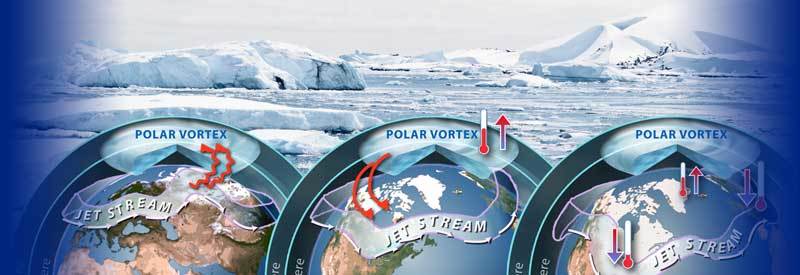
In recent times, a meteorological phenomenon called a Polar Vortex started generating much attention due to its devastating effects on countries in the Northern Hemisphere. We take a closer at this event.
A polar vortex is defined as a permanent low-pressure system centered above the Earth's poles. In the Arctic Circle, it extends from 11 to 50 kilometers in altitude. The air rotates counter-clockwise and is kept in place by the Polar Front Jet Stream, with icy temperatures as low as -80° Celsius.
The name "Polar Vortex" surfaces in the mainstream media every once in a while. Usually, when it misbehaves and reaches further south than it is supposed to, and impacts the lives of millions of people in countries in the Northern Hemisphere.
We first have to quickly clear up the misconception that a Polar Vortex itself is the problem or abnormal in any way. We will address this issue and also go into detail explaining why and when it becomes dangerous.
Polar Vortex Definition
Before getting into further detail about how a polar vortex works and how its impacts the environment, one first has to describe what precisely this meteorological phenomenon is:
What Is A Polar Vortex?
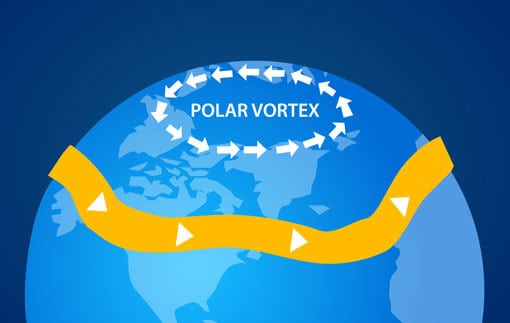
In the Northern Hemisphere, a polar vortex is a permanent low-pressure system that is present in the mid-to-upper atmosphere centered above the Arctic and extends from 11-50 kilometers (7-31 miles) in altitude.
It rotates counter-clockwise above the polar region and is characterized by freezing temperatures of up to -80° Celsius (-112° Fahrenheit). It is kept in place by a strong wind system called the Polar Front Jet Stream.
This low-pressure system is kept in place by the Polar Front Jet Stream. These strong winds circle the polar vortex at high speeds in excess of 257 km/h (160 mph).
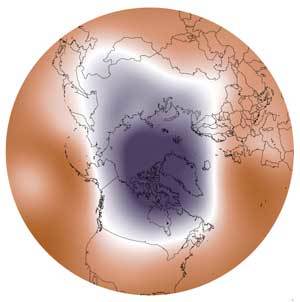
The Polar Front Jet Stream surrounding the polar vortex operates at a lower altitude of around 10 kilometers (7 miles), but its constant high-speed rotation is sufficient to keep the polar vortex in place and stable.
It is very important to understand that the polar vortex itself is a normal phenomenon that is permanently situated above the North Pole. As long as the vortex remains strong and stable and doesn't lose its shape, it doesn't affect or pose a danger to sub-polar regions.
Simply put, a strong polar vortex is a safe polar vortex.
When A Polar Vortex Becomes Dangerous
Now that we established what a normal polar vortex is, we need to examine when and how it starts to "misbehave" and threaten regions further to the south.
Usually, a strong polar vortex helps the circulating jet streams to stay strong and keeps them in shape. The polar jet stream also forms the boundary between the cold polar vortex air and the warmer subtropical air.
With air temperatures within the polar vortex reaching -80° Celsius (-130° Fahrenheit) in the mid-upper atmosphere, the maintenance of a strong boundary between the Arctic and subtropical air is essential.
It is when the low-pressure system in the polar vortex starts to weaken that an unstable environment is created.
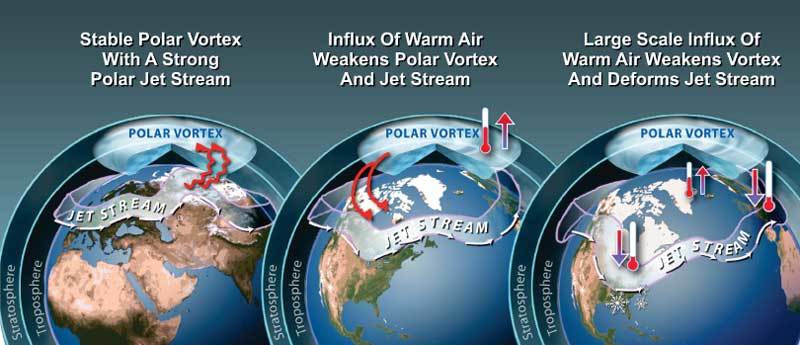
Illustration Showing The Influx Of Warm Air Weakening And Deforming The Polar Jet Stream
There are a variety of ways in which the vortex can weaken (which we will discuss later in the article), but it is usually the presence of warmer temperatures that disrupts the strong low-pressure system that holds the polar vortex together.
When the warmer air mixes with cold Arctic air, the low-pressure system starts to weaken substantially. This has a direct effect on the polar jet stream surrounding it.
The strength of the jet stream relies on the strength of the temperature difference between the cold Arctic and subtropical air. The warmer air in the Arctic causes this difference in air temperatures to weaken.
As a result, the jet stream weakens and starts to lose its normal shape and structure. It begins to wind and flow in a more wavy manner, causing its borders to reach much further south than usual.
The weakened low-pressure system and a compromised jet stream can even cause a polar vortex to split, where the primary vortex is broken down into smaller vortices, and each piece can move in different directions. This is commonly referred to as a Polar Outbreak.
Regions that would typically not be affected under stable conditions are now directly exposed to Arctic temperatures. (It may even dip below Arctic temperatures as it is exposed to air similar to that we usually found in the mid-upper atmosphere above the North Pole.)
And this is the real danger of a polar vortex. When a vortex weakens, the polar jet stream weakens and loses its shape, causing the wavy border that can wander far south and affect areas that would normally not be exposed to this phenomenon at all.
Simply put, a weak polar vortex is an unstable and dangerous polar vortex.
what causes polar vortex To weaken
Now that you know why a polar vortex can become so dangerous and that temperature plays a major role in the weakening of the polar vortex, we need to try and establish what the reason for these disturbances in temperature is.
Meteorologists are not completely sure themselves and are still debating the underlying causes that may lead to these dangerous polar outbreaks.
There are quite a few viable explanations, though, some of which have already been proven.
1) Arctic Amplification
An accelerated rise in temperatures over the last couple of decades globally has already been recorded and confirmed. (No, this not an argument for or against climate change. It is simply a statement of the facts.)
In the Arctic Region, the situation is even worse. Surface temperature in this area has been warming at twice the rate of the global average.
The melting of snow cover and sea ice is mainly responsible for this accelerated warming of air temperatures in the polar regions. The white snow and ice usually reflect the majority of heat from the sun. The darker waters of the ocean in, contrast, absorb and retain the heat.
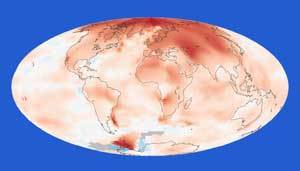
Heat Map of Arctic Amplification Courtesy of NASA
With less ice and snow present, more heat gets absorbed and retained by the exposed ocean water. The resulting warmer air, combined with global warming, leads to this accelerated rise in temperature, which is known as Arctic Amplification.
This phenomenon causes the warmer air over the Arctic to move in from the sides of the polar vortex and disrupt the cold air. This causes the weakening of the vortex and deformation of the jet stream, as I described in the previous section.
As the polar vortex becomes more severely disrupted, Arctic Amplification can cause the vortex to split into multiple vortices, which leads to a Polar Outbreak.
And, as already discussed, it is the movement of these multiple vortices that can cause the polar jet stream to veer seriously off course and reach areas much further south.
2) Climate Change
You can argue that Arctic Amplification is a direct result of global warming. This implies that, indirectly, Climate Change is responsible for the weaker polar vortex, which deformed shape causes it to venture south and impact countries in the Northern Hemisphere.
It leaves the question of whether Climate Change can be more directly linked to a polar vortex. To be honest, no direct link or specific body of evidence between Climate Change (global warming) and "wondering" polar vortices has been established yet.
Scientists and meteorologists have bits and pieces of evidence that point to a more direct correlation between the two, but more research and gathering of data needs to be done before something concrete can be deducted and a conclusion reached.
Dangers & Consequences Of a Polar Vortex
Once the polar jet stream gets disrupted to the point where it loses its shape and takes on a wavy form, regions not used to the extreme cold now get exposed to Arctic temperatures with potentially fatal consequences.
I am not sure anyone who hasn't experienced the full brunt of a polar vortex can fully grasp the severity and danger that accompanies this phenomenon.
An extreme example of a polar vortex engulfing and trapping huge parts of the United States Of America in January 2019 can be used as a perfect example of just how bad things can get.
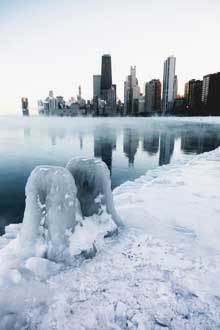
Chicago Experiencing The Extreme Cold Temperatures Associated With A Polar Vortex
Cities and towns in Minnesota experienced some of the most extreme cold weather in history, which is a direct result of the polar vortex. Looking at the conditions they were exposed to, and the resulting consequences will help to shine some light on the dangers of such an event.
In Cotton, Northern Minnesota, temperatures dropped as low as -49° Celsius (-56° Fahrenheit). Chicago wasn't too far behind Cotton, with temperatures reaching lows of -30° Celsius (24° Fahrenheit).
These temperatures were colder than those experienced at the North Pole and Antarctica during the same period! This is enough to cause severe health issues within seconds.
People were advised to stay indoors, schools were closed, flights canceled, and the USPS canceled mail deliveries during this period. And with good reason.
These are some of the dangerous conditions and health risks that existed during this period.
Dangerous Transport & Infrastructure Conditions
Roads were instantly iced over, especially with black ice, making it extremely slippery and dangerous to drive on. (You can read more in-depth detail about black ice and other cold/ice-related phenomena in this article.)
Railway tracks were literally set on fire to prevent them from contracting due to the cold, which would have resulted in gaps in the tracks.
The accompanying snowfall on roads and railways in many areas made travel almost impossible, and commuters got stuck on roads across the country.
Hypothermia
In subzero temperatures, it can only take minutes for your body's temperature to drop below its core temperature. In the extreme cold of a polar vortex, this process is accelerated.
If not treated immediately, this condition is normally deadly, and quite a few fatalities were recorded during this period in the coldest states.
Frostbite
Frostbite occurs when your skin comes in contact with freezing temperatures, especially those as low as that experienced during a polar vortex.
It happens really fast to exposed skin and under these extreme conditions, and it can take only five minutes of exposure.
Frostbite leads to the skin and underlying tissue to die. In the severe conditions of a polar vortex, prolonged exposure can even lead to the loss of digits and limbs.
(You can read more in-depth detail about frostbite in this article.)
These are just a few of the many dangers that accompany a polar vortex when a region is exposed to its full force.
Conclusion
Now that you have a good idea of exactly what a polar vortex is and what causes it to become dangerous, you will now be able to better understand such an event.
You will also have a better understanding of the conditions that normally accompany this phenomenon and how dangerous it can get.
With the occurrence of polar vortices increasing and appearing more frequently, this may be a condition we may have to prepare for as the "new normal."
Never miss out again when another interesting and helpful article is released and stay updated, while also receiving helpful tips & information by simply following this link .
Until next time, keep your eye on the weather!
